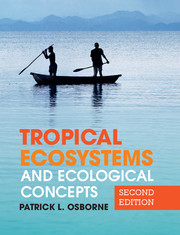Book contents
- Frontmatter
- Contents
- Preface
- Abbreviations and units
- Chapter 1 The tropical environment and climate
- Chapter 2 Dry, hot deserts and environmental factors
- Chapter 3 Grasslands and primary production
- Chapter 4 Savanna and population dynamics
- Chapter 5 Lakes, energy flow and biogeochemical cycling
- Chapter 6 Rivers, floodplains and estuaries
- Chapter 7 Wetlands and succession
- Chapter 8 Tropical rain forests and biodiversity
- Chapter 9 Mountains, zonation and community gradients
- Chapter 10 Mangroves, seagrasses and decomposition
- Chapter 11 Coral reefs and community ecology
- Chapter 12 Islands, archipelagos, biogeography and evolutionary ecology
- Chapter 13 Cities and human ecology
- Glossary
- References
- Index
- References
Chapter 10 - Mangroves, seagrasses and decomposition
Published online by Cambridge University Press: 05 June 2012
- Frontmatter
- Contents
- Preface
- Abbreviations and units
- Chapter 1 The tropical environment and climate
- Chapter 2 Dry, hot deserts and environmental factors
- Chapter 3 Grasslands and primary production
- Chapter 4 Savanna and population dynamics
- Chapter 5 Lakes, energy flow and biogeochemical cycling
- Chapter 6 Rivers, floodplains and estuaries
- Chapter 7 Wetlands and succession
- Chapter 8 Tropical rain forests and biodiversity
- Chapter 9 Mountains, zonation and community gradients
- Chapter 10 Mangroves, seagrasses and decomposition
- Chapter 11 Coral reefs and community ecology
- Chapter 12 Islands, archipelagos, biogeography and evolutionary ecology
- Chapter 13 Cities and human ecology
- Glossary
- References
- Index
- References
Summary
Mangroves occur between the sea and the land and line approximately 75% of tropical coasts. The term mangrove refers to both the plant community found in this saline, intertidal zone as well as the constituent tree and shrub species that grow there. Even though mangroves include plants from different genera and families, they exhibit similarities in appearance, physiology, reproduction and adaptation to habitat. This provides another example of convergent evolution (see section 8.7). Defining a mangrove as a particular type of plant without reference to its habitat is unsatisfactory since many mangrove adaptations such as stilt roots and pneumatophores are found in plants growing in areas other than the coastal zone. If one accepts the view that mangroves (the habitat) are tidal forests (Schimper 1903), then one can define a mangrove (the plant) as any woody species that grows in these forests. It should be noted that this will include species that grow outside the coastal zone, and indeed, some mangrove plants are not confined to the tidal zone.
Mangroves inhabit a changeable environment. With each high tide the sea inundates the roots and lower portions of mangrove stems. At low tide, the sediment may be completely exposed or, if the mangrove occurs along an estuary, roots may be bathed in fresh water. Tidal range varies from place to place and also with the relative positions of the Earth, moon and sun. The range is at a maximum at new and full moon (spring tides) and at a minimum (neap tides) in between full and new moon; spring tides are highest at the equinox.
- Type
- Chapter
- Information
- Tropical Ecosystems and Ecological Concepts , pp. 334 - 357Publisher: Cambridge University PressPrint publication year: 2012



